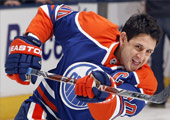Hockey, like all sports, can be dangerous. As a player moves through the ranks from pee wee leagues into traveling teams and collegiate play, the risk increases. Players at all levels are much more likely to get hurt during intense game situations than during drills.
Expert Injury Avoidance Advice
The chance of getting hurt depends heavily on player position, their equipment and their history of injury. Style of play and a tendency to be involved in fights or other violent behavior also increases the chance of a player being injured. Hockey injuries can occur anywhere on the body, although some are more common than others.
Concussions and Closed Head Injuries
Concussions and closed head injuries are not as common in hockey as they once were thanks to the advances in helmet and equipment technology. They still happen, though, and probably more frequently than we realize. Concussions do not usually cause a loss of consciousness, but sometimes the player will just feel out of sorts and complain of a headache. A concussion – even one resulting from a mild hit or that does not cause loss of consciousness – is a serious matter. Any player complaining showing signs of injury after a blow to the head should be evaluated by a team doctor or other medical professional immediately.
Shoulder, Elbow and Wrist Injuries
Shoulder separations and broken collarbones occur fairly frequently in hockey, thanks to hard contact with the boards, the ice or even another player. In most cases they only require sitting out a few games and wearing a sling, but serious or repeated injuries can require surgery.
Wrist fractures are the second most common arm-related injury in hockey. Attempting to brace themselves while falling or being slammed into the boards is the way most players break their wrists. In on-ice drills, players are typically taught to brace themselves with a flat forearm but this does not always translate in game situations.
Elbow injuries have been reduced greatly today versus in years past because most players wear well-fitting pads with plenty of padding and an outer protective shell. In the past, the elbow was often injured through hard contact. Still, if repeated contact occurs, players can develop bursitis in the elbow which causes pain and inflammation.
Back Injuries
Low back injuries including pulled muscles are common in hockey players because of the high frequency of hyperextension during the game. Strengthening the core muscles and those in the lower back can help to prevent back injuries in hockey players.
Hip Injuries
The most common issues for hockey players are soft tissue injuries in the lower body. These occur frequently in the hip adductors, known to many as a groin strain. Strengthening both the hip abductors and adductors are important to prevent injuries as well as to gain power and speed on the ice. Hockey pants typically have padding over the hips, and this reduces the risk of direct hits to the hips that can cause more severe injuries from falls or direct blows by other players.
Knee Injuries
Most sports put players at risk for anterior cruciate ligament or meniscus tears, and hockey is no exception. The risk, however, is lower in hockey than in most land-based sports. Because of the way the legs stride on the ice, however, hockey players are at an increased risk for medial collateral ligament damage.
Most injuries sustained by hockey players are extremely mild, especially with today’s standards for safety equipment. The most common of all injuries are small bruises and cuts which result in little lost playing time and no permanent damage. For more expert injury avoidance advice, contact our professional trainers at HockeyOT. We can help you design drills and strength training workouts for players of any age, and minimize the risk of injury.














